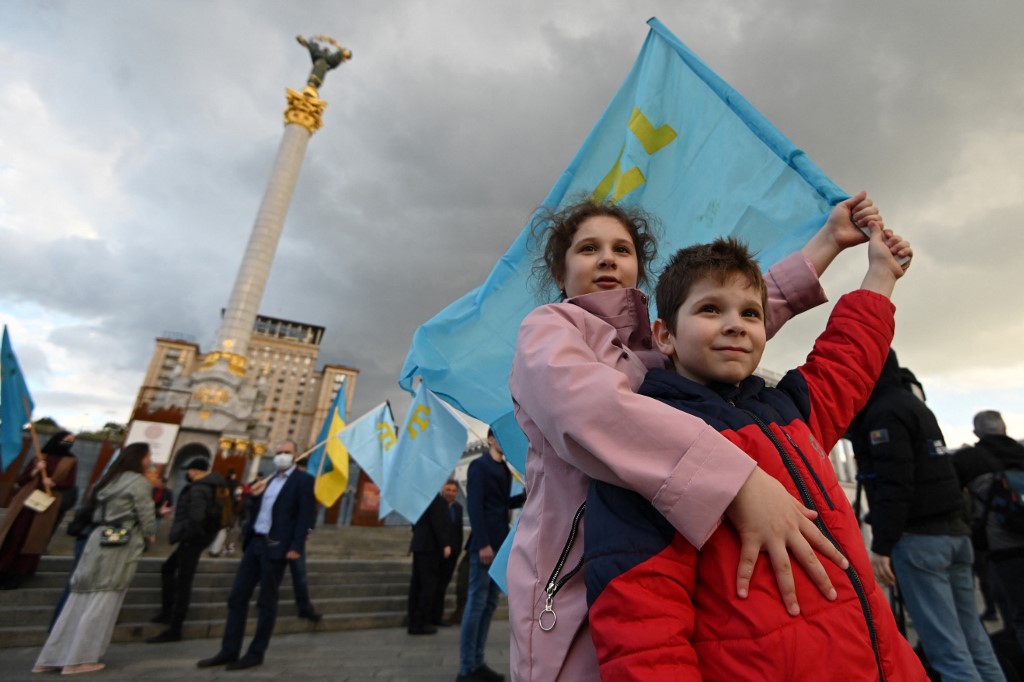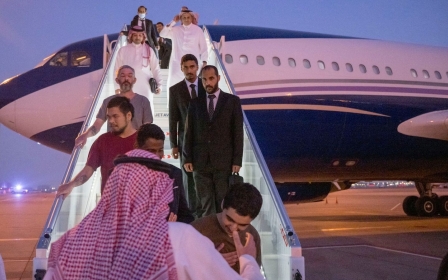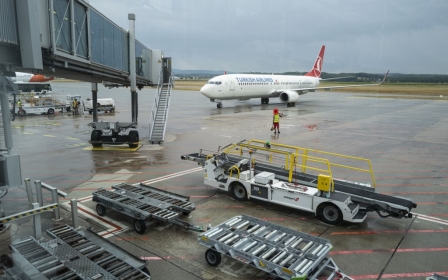Crimean Tatars caught between Russia and Ukraine
In the last few days, Ukraine's President Volodymyr Zelensky pledged to "liberate" Crimea and accused the Russian government of trying to kill Crimean Tatars through Russia's recent military mobilisation.
Turkish President Recep Tayyip Erdogan also declared that Russia should "return" Crimea to its "rightful owners".
Referring to the Crimean Tatars, Erdogan said that he had told Russian President Vladimir Putin: "These are our descendants at the same time, the people who are living there. If you were to take this step forward, if you could leave us, you would also be relieving the Crimean Tatars and Ukraine as well."
But this begs the question: who are Crimea's "rightful owners" - the Russians, Ukrainians, or Tatars?
New MEE newsletter: Jerusalem Dispatch
Sign up to get the latest insights and analysis on Israel-Palestine, alongside Turkey Unpacked and other MEE newsletters
A colonial project
Since the late 18th century, Crimea's history has been characterised by settler-colonisation, starting with Russia's German Tsarina Catherine the Great.
Catherine's 'Greek Project' aimed to reestablish the Roman Empire, or 'Byzantium', in a recaptured Constantinople
Her colonial project was crowned with the defeat of the Ottomans in the Russo-Turkish War of 1768-1774. The Ottomans lost their territories in the northern Caucasus, including Crimea and the Kuban regions, causing thousands of Tatars to flee to the rest of the Ottoman Empire.
The first wave of Russian settlers arrived in Crimea in 1778 and elicited an immediate revolt by Crimean Tatars, which Catherine put down before annexing Crimea in 1783.
In 1787, the Ottomans launched a war against Russia to regain Ottoman lands, which led to another defeat and loss of territory, including the Sanjak of Özi on the northern parts of the Black Sea, near Crimea.
Russification ensued and the Black Sea town of Hacibey in the Sanjak of Özi was expanded into a new Russian settler-colony named "Odessa" in 1794. The renaming of Odessa was part of the revival of the ancient Greeks in the conquered areas.
The mostly Greek names were important, serving "to eliminate any memory of the barbarians" and as "the first step toward ridding Europe of the Mohammedans and conquering Istanbul", as the then Russian Attorney General AN Samoilov explained.
Catherine's "Greek Project" aimed to reestablish the Roman Empire, or "Byzantium", in a recaptured Constantinople. On the Crimean Peninsula, she established the city of Sebastopol in 1783 on the site of the Tatar town of Akhtiar and renamed the Tatar town of Aqmescit (white mosque) "Simferopol" in 1784.
Crimea itself was renamed the "Taurida Governorate" in honour of the Greek Tauris.
Jewish colonisation
By 1810, the Russian government dispatched 10,000 landless Jews from Belorussia and Lithuania to the Kherson Province, renamed after its conquest, and located just north of Crimea. More Jewish colonists arrived in the 1820s and 1830s in Kherson and its environs.
By the late 1840s, the colonists were officially designated "Jewish-agriculturalists". In 1866, Jewish colonial settlement in New Russia was officially halted as not economically viable, though existing Jewish colonies were preserved.
At the end of 1920, following the Russian Revolution, Crimea was the last bastion of the counterrevolutionaries to fall to the Soviets.
Their local Tatar allies, the socialist Milliy Firqa, or National Party, formed in the summer of 1917. In October 1921, the Crimean Autonomous Soviet Socialist Republic was established as part of Soviet Russia.
Crimean Tatar communists took charge and their leader Veli Ibrahimov became the first chairman of the Crimean Central Committee and head of the Crimean Council of People’s Commissars.
Meanwhile, in November 1924, the American Jewish Joint Distribution Committee, an organisation formed to help East European Jews during World War I, established the Joint Agricultural Corporation (Agro-Joint) to promote "the mass transfer to productive occupations" of the 2.5 million Soviet Jews whose regions were devastated during the Civil War. Agro-Joint reached an agreement with the Soviet government whereby funds were provided in equal proportions by the two parties for the project.
The Soviets had already established the "Committee for the Settlement on Land of the Jewish Toilers", or Komzet, and prepared plans to settle 100,000 Jewish families. The plans included rebuilding the agricultural Jewish colonies in southern Ukraine and sending Jewish colonial-settlers to Crimea. In view of the economic devastation of shtetl life between 1917 and 1921, the Soviets viewed Jewish colonisation as the fastest option to end Jewish poverty.
In 1925, despite resistance by the locals, 100,000 Jews were settled, increasing to 250,000 by 1928, mainly in southern Ukraine and Crimea. The settlers lived in about 250 colonies on one million acres of land.
Due to Tsarist settler-colonialism, Crimea already had a large population of Russian, Ukrainian, German, and Jewish colonists. The total population of Crimea in 1921 was 720,000. The pre-revolution Tatar population had been significantly reduced by the flight of Tatars, making them a quarter of Crimea's population, which alarmed Soviet Tatar communist leaders.
Restoring Tatars
After the Civil War and the stabilisation of Soviet rule, Crimea itself was in the process of granting lands to the native Tatar Crimean peasants. Ibrahimov instituted policies to restore the Tatar language and cultural rights and invited Crimean Tatars who fled or were expelled by the Tsars to return home. The Soviets also officially restored the Tatar name Ak Mecit to the city of Simferopol and made Tatar the official language of Crimea alongside Russian.
The Crimean communist party and the government, however, opposed the plan for Jewish settler-colonisation, especially as the appropriated land infringed on their programme of land distribution to poor Tatar peasants. Whereas the other colonial-settler communities of Russians and Germans lived under local Crimean authority, the new Jewish settler-colonies were to be administered by Komzet and Agro-Joint.
The opposition of Ibrahimov and other Tatar leaders was motivated by a Communist anti-colonial agenda that sought to benefit the Tatar native peasants whose lands had been ravaged under the Tsars.
Ibrahimov established two dozen villages for the Tatar peasants and for Tatar returnees, former refugees in Bulgaria and Romania. He protested officially the Jewish colonisation scheme and moved 8000 Tatars to the Crimean steppe to pre-empt Moscow's plans.
By the winter of 1927-28, the newly consolidated Stalin leadership tried and executed Ibrahimov on the charge that he opposed not settler-colonialism, but Soviet collectivisation of land. He was shot in May 1928 and was replaced by Ahmed Kubay as head of the Tatar Communist Party.
Nazi invasion
By 1929, land reform and collectivisation proceeded apace and 86 Jewish colonies with a population of 20,000 were established in Crimea. The remaining 170 colonies or so were established in southern Ukraine.
In 1928, the Soviet government, in view of Ukrainian and Crimean resistance to Jewish colonisation, declared that it had allocated lands in Birobidzhan on the Chinese border "for the needs of mass settlements by Jewish toilers". Birobidzhan acquired the status of a Jewish Autonomous Region in 1934.
The Jewish colonists prospered in Ukraine until the Nazi invasion of the USSR in June 1941, which was intended to realise the secret Nazi "Masterplan East" that would colonise and repopulate the European parts of the USSR and Crimea - which SS chief Heinrich Himmler, the plan's author, wanted to rename "Gothengau" or "Goth District" with ethnic Germans.
The Soviets evacuated the Jewish population behind army lines in Central Asia to save them from the Nazis. Those who could not evacuate were killed by the invading Germans and local collaborators. Nazi Wehrmacht General Erich von Manstein informed his soldiers in Crimea that they were to ensure that the Jews never again threatened Germany's Lebensraum.
Nazi collaborators
Like neighbouring nationalist Ukrainian collaborators with the Nazis, thousands of Crimean Tatars became Nazi collaborators during the Nazi occupation of Crimea, even though part of the local Soviet resistance to the Germans also included thousands of Tatars, not to mention the 20,000 Tatars who were serving in the Red Army on the front.
On the ground in Nazi-occupied Crimea, many Tatars served in the Nazi-run police force, just as many had joined the resistance against the Germans
Turkey-based anti-Soviet Tatar leaders met with Hitler and arranged for 20,000 Tatar prisoners of war to fight in a pro-Nazi military legion consisting of eight battalions in support of the Wehrmacht.
On the ground in Nazi-occupied Crimea, many Tatars served in the Nazi-run police force, just as many had joined the resistance against the Germans.
The Nazis also shipped thousands of Crimean Tatars to work in Germany as ostarbeiters - foreign slave workers - during the occupation (1941-1944). Before the Nazi withdrawal, thousands of collaborators were evacuated to eastern Europe.
Following the liberation of Crimea, Stalin's first lieutenant, Lavrentiy Beria, ordered the deportation of the entire 200,000 Crimean Tatar population in May 1944. They were forcibly settled in Uzbekistan and neighbouring Central Asian republics. Russian and Ukrainian settlers were dispatched to take over their lands.
In 1956, the Soviet government repudiated the Stalinist deportation decision, exculpating the Tatars of the charge of "mass treason".
However, Khrushchev's government, while restoring linguistic rights, did not permit Tatar repatriation to Crimea, which had been completely transformed by Stalin's post-1944 policy of Russian and Ukrainian settler-colonisation. Significantly, in 1954, Khrushchev transferred sovereignty of Crimea from Russia to Ukraine for administrative reasons.
Right to repatriate
Many Crimean Tatars began to move back to Crimea after 1967 and throughout the 1970s. Finally, in 1989, the Soviet government granted Tatars the right to repatriate and sponsored and financed their repatriation until the collapse of the USSR in 1991.
By 1994, almost a quarter of a million Crimean Tatars had returned to Crimea, half the Crimean Tatar population at the time. The nationalists amongst them set up a Tatar Council, called the "Mejlis" in 1991.
Already by the late 1990s, leaders of the Tatar nationalist returnees allied themselves with right-wing Ukrainian political forces, including the Rukh party.
The Ukrainian nationalist right in turn saw the Tatars as useful pawns in their quest to keep Crimea within Ukraine after Ukraine's independence, even though the majority of Crimea's population, descendants of Russian settlers, wanted to be reunified with Russia.
The Tatars now living under Ukrainian sovereignty lived in utter poverty with few government services extended to them and squatted on lands which the government refused to grant them, as the World Bank reported in 2002.
Following the 2014 western-organised coup against the elected government of Ukraine, which led to the bloodless Russian takeover of Crimea, Russia annexed the peninsula.
After annexation, the Russian government granted legal rehabilitation for Tatar suffering under Stalin and granted official status to the Crimean Tatar language. It was after Russia's annexation of Crimea, and in a bid to further exploit the Tatar issue, that the Ukrainian parliament officially recognised the Tatar Mejlis, and only then did the Ukrainians recognise the Crimean Tatars as the "indigenous" people of Crimea.
But as a nationalist Tatar Mejlis opposed Russia and allied itself with Ukraine, a Russian court disbanded it in 2016, accusing it of fomenting ethnic hatred and of terrorist activity, including a series of explosions in November 2015 that damaged power lines causing a mass power outage in Crimea, a charge which the Mejlis denied.
The Mejlis and western human rights groups countered that the Russian decision unfairly targeted Tatar national rights generally.
Meanwhile, right-wing Crimean Tatars who supported the Ukrainian coup formed in 2016 a Tatar Battalion which helped Ukrainian forces lay siege to Crimea and received assistance from Erdogan's Turkey. The right-wing Ukrainian Azov Battalion, widely seen as Nazi in ideology, includes Crimean Tatar fighters in its ranks.
The current right-wing leadership of the Crimean Tatars have again placed the entire Tatar community in harm's way.
Crimean Tatar rights have come to be exploited and compromised not only by Russian and Ukrainian nationalists - not to mention Turkish nationalists - for their own benefit and at the expense of the long-suffering Crimean Tatar people, but also by western powers intent on humiliating and weakening Russia.
That the US and EU and the Ukrainian regime have come to support Crimean Tatars' legitimate national rights recently is no more a principled position than those powers' longstanding opposition to the indigenous rights of the Palestinian people.
Russian authorities' prosecution of right-wing Tatars today who oppose and agitate against Russian sovereignty is motivated by the determination to keep Crimea part of Russia, rather than a denial of Tatar national and cultural rights, ongoing western propaganda to the contrary notwithstanding.
None of this means that Russian and Ukrainian nationalists in Moscow and Kyiv or those in Crimea do not hold racist colonial-settler views of the Crimean Tatar minority.
But it does mean that the continued ideological commitments and alliances of the right-wing Crimean Tatars' misleadership will yet again cause their people more hardship and tragedies.
The views expressed in this article belong to the author and do not necessarily reflect the editorial policy of Middle East Eye.
Middle East Eye delivers independent and unrivalled coverage and analysis of the Middle East, North Africa and beyond. To learn more about republishing this content and the associated fees, please fill out this form. More about MEE can be found here.









